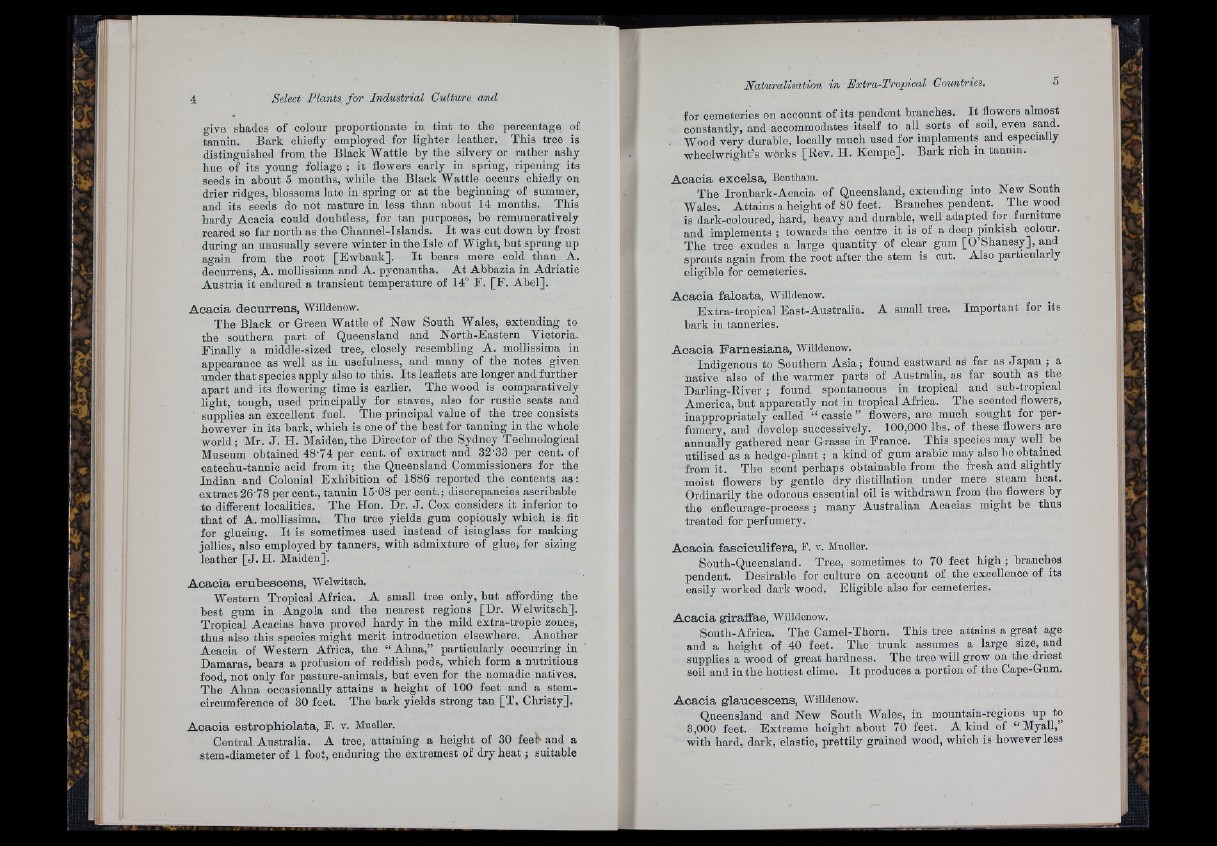
give shades of colour proportionate in tin t to the percentage of
tannin. Bark chiefly employed for lighter leather. This tree is
distinguished from the Black Wattle by the silvery or rather ashy
hue of its young foliage ; it flowers early in spring, ripening its
seeds in about 5 months, while the Black Wattle occurs chiefly on
drier ridges, blossoms late in spring or at the beginning of summer,
and its seeds do not mature in less than about 14 months. This
hardy Aeacia could doubtless, for tan purposes, be remuneratively
reared so far north as the Cliannel-Islands. I t was cut down by frost
during an unusually severe winter in the Isle of Wight, but sprung up
again from the root [Ewbank], I t bears more cold than A.
decurrens, A. mollissima and A. pycnantha. A t Abbazia in Adriatic
Austria it endured a transient temperature of 14° F. [F . Abel].
A c a c ia d e c u rr e n s , Willdenow.
The Black or Green Wattle of New South Wales, extending to
the southern part of Queensland and North-Eastern Victoria.
Finally a middle-sized tree, closely resembling A. mollissima in
appearance as well as in usefulness, and many of the notes given
under th a t species apply also to this. I ts leaflets are longer and further
apart and its flowering time is earlier. The wood is comparatively
light, tough, used principally for staves, also for rustic seats and
supplies an excellent fuel. The principal value of the tree consists
however in its bark, which is one of the best for tanning in the whole
world; Mr. J . H. Maiden, the Director of the Sydney Technological
Museum obtained 48'74 per cent, of extract and 32'33 per cent, of
catechu-tannio acid from it; the Queensland Commissioners for the
Indian and Colonial Exhibition of 1886 reported the contents as:
extract 26'78 per cent., tannin 15-08 per cent.; discrepancies ascribable
to different localities. The Hon. Dr. J . Cox considers it inferior to
th a t of A. mollissima. The tree yields gum copiously which is fit
for glueing. I t is sometimes used instead of isinglass for making
jellies, also employed by tanners, with admixture of glue, for sizing
leather [ J . H. Maiden].
A c a c ia e ru b e s c e n s , Welwitsch.
Western Tropical Africa. A small tree only, but affording the
best gum in Angola and the nearest regions [Dr. Welwitsch].
Tropical Acacias have proved hardy in the mild extra-tropic zones,
thus also this species might merit introduction elsewhere. Another
Acacia of Western Africa, the “ Ahna,” particularly occurring in
Damaras, bears a profusion of reddish pods, which form a nutritious
food, not only for pasture-animals, but even for the nomadic natives.
The Ahna occasionally attains a height of 100 feet and a stem-
circumference of 30 feet. The bark yields strong tan [T . Christy].
A c a c ia e s tro p h io la ta , S’, v. Mueller.
Central Australia. A tree, attaining a height of 30 feefr and a
stem-diameter of 1 foot, enduring the extremest of dry h e a t ; suitable
for cemeteries on account of its pendent branches. I t flowers almost
constantly, and accommodates itself to all sorts of soil, even sand.
. Wood very durable, locally much used for implenaents and especially
wheelwright’s works [Rev. H. Kempe]. Bark rich in tannin.
A c a c ia ex c e lsa , Bentham.
The Ironbark-Acacia of Queensland, extending into New South
Wales. Attains a height of 80 feet. Branches pendent. The -wood
is dark-coloured, hard, heavy and durable, well adapted for furniture
and implements ; towards the centre it is of a deep pinkish colour.
The tree exudes a large quantity of clear gum [O ’Shanesy], and
sprouts again from the root after the stem is cut. Also particularly
eligible for cemeteries.
A c a c ia f a lc a ta , Willdenow.
Extra-tropical East-Australia.
bark in tanneries.
A small tree. Important for its
A c a c ia P a rn e s ia n a , Willdenow.
Indigenous to Southern A s ia ; found eastward as far as Japan ; a
native also of the warmer parts of Australia, as far south as the
Darling-River ; found spontaneous in tropical and sub-tropical
America, hut apparently not in tropical Africa. The scented flowers,
inappropriately called “ cassie ” flowers, are much sought for perfumery,
and develop successively. 100,000 lbs. of these flowers are
annually gathered near Grasse in France. This species may well be
utilised as a hedge-plant ; a kind of gum arable may also be obtained
from it. The scent perhaps obtainable from the fresh and slightly
moist flowers by gentle dry distillation under mere steam heat.
Ordinarily the odorous essential oil is withdrawn from the flowers by
the enfleurage-process ; many Australian Acacias might be thus
treated for perfumery.
A c a c ia fa s c ic u life ra , F. v. Mueller.
South-Queensland. Tree, sometimes to 70 feet high ; branches
pendent. Desirable for culture on account of the excellence of its
easily worked dark wood. Eligible also for cemeteries.
A c a c ia g ira ffa e , Willdenow.
South-Africa. The Camel-Thorn. This tree attains a great age
and a height of 40 feet. The trunk assumes a large size, and
supplies a wood of great hardness. The tree will grow on the driest
soil and in the hottest clime. I t produces a portion of the Cape-Gum.
A c a c ia g-laucescens, Willdenow.
Queensland and New South Wales, in mountain-regions up to
3,000 feet. Extreme height about 70 feet. A kind of “ Myall,
with hard, dark, elastic, prettily grained wood, which is however less